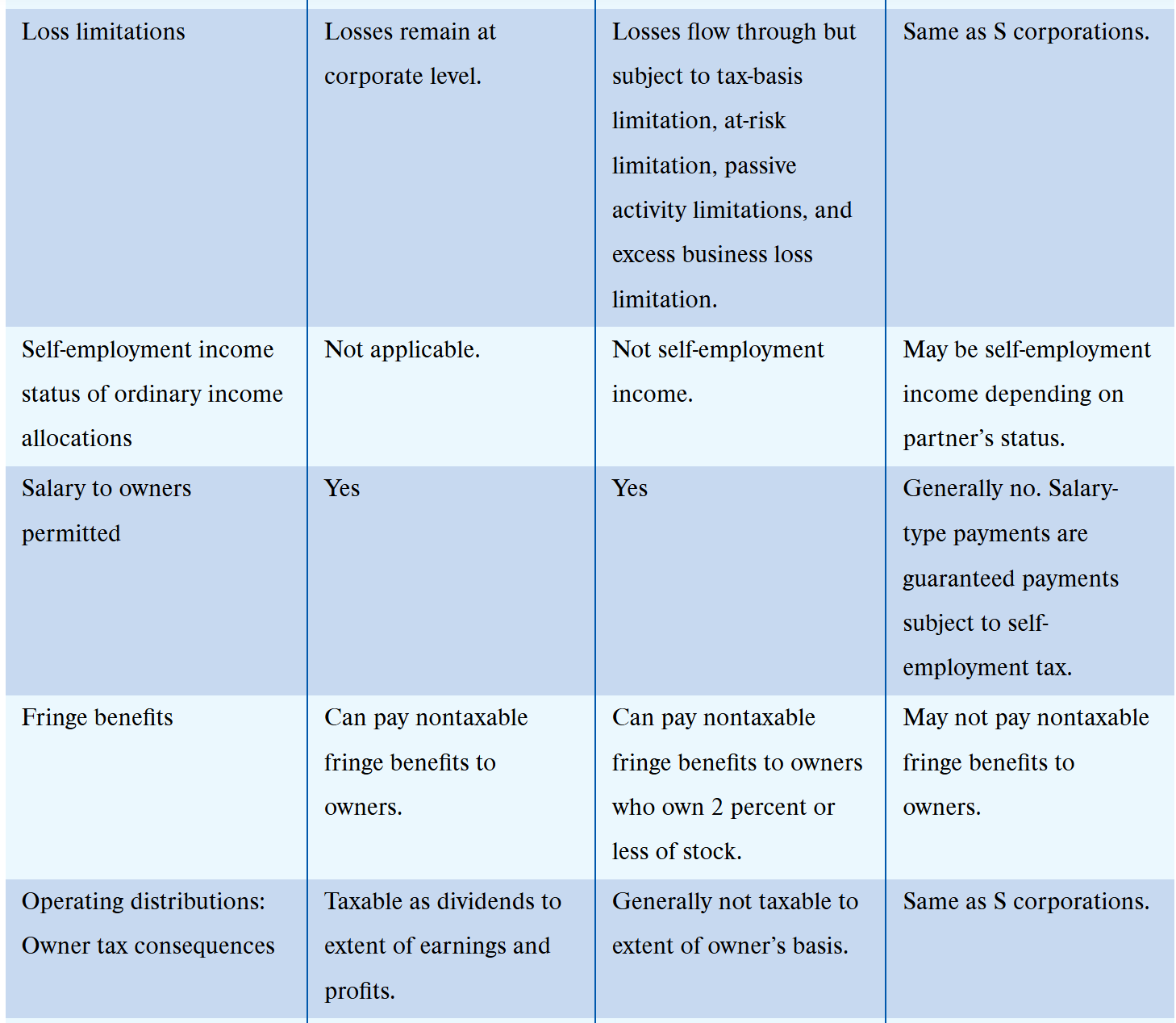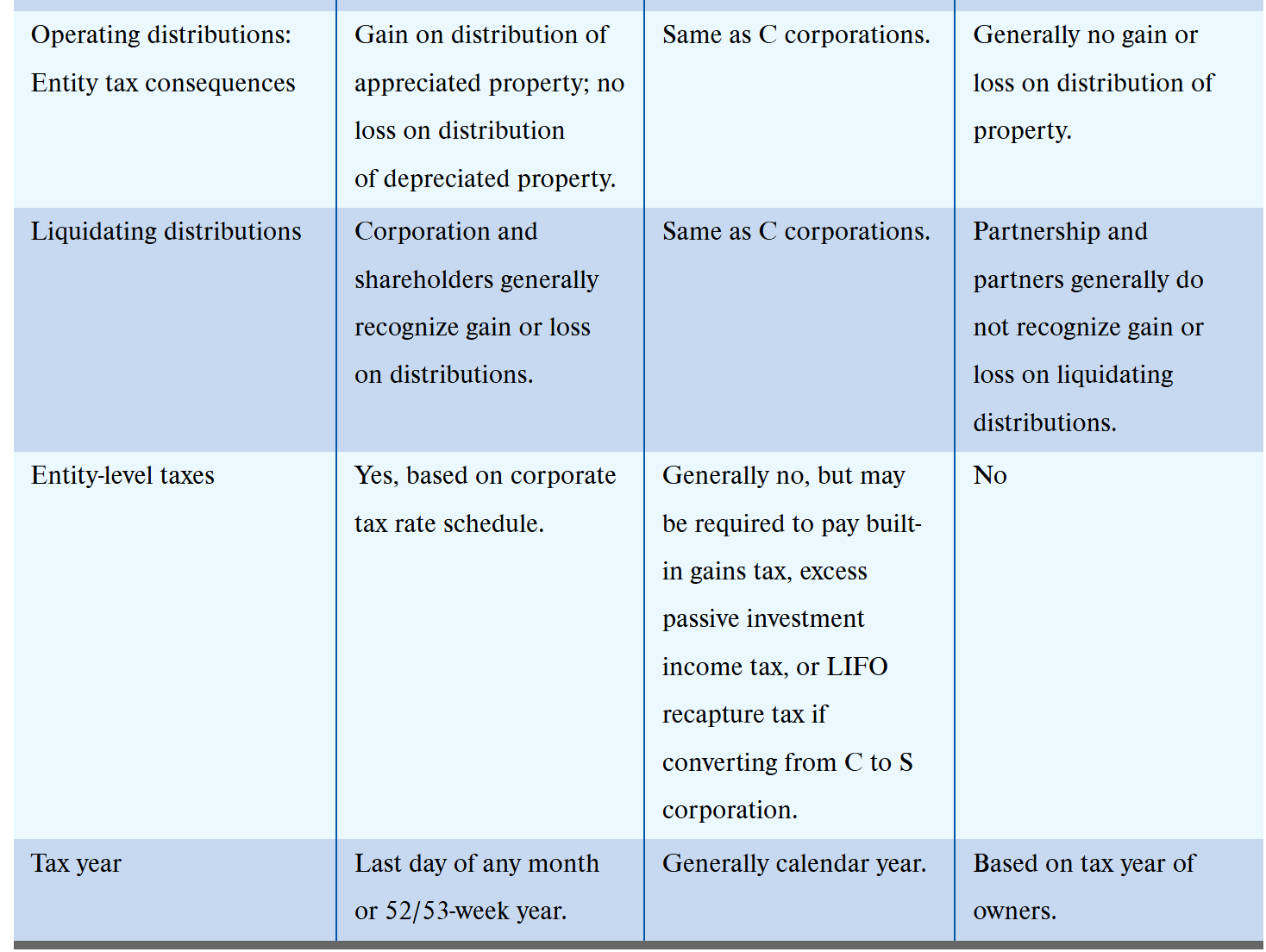Chapter 11: S Corporations
1/33
There's no tags or description
Looks like no tags are added yet.
Name | Mastery | Learn | Test | Matching | Spaced |
|---|
No study sessions yet.
34 Terms
S Corporations
S Corporations are hybrid entities, sharing characteristics with C corporations and partnerships
They are either incorporated under state law, have same legal protections as C corporations and have elected S corporation status or are noncorporate business entities that have elected to be treated as a corporation and then elect S corporation status
S corporations are governed by same corporate tax rules that impact organization, liquidation and reorganization of C corporations
However, they are flow through entities and share many tax similarities with partnerships
Basis calculations are similar, distributions are generally not taxed to the extent of owner basis and income/loss flows through to owners
S Corporation Elections
Formations
Same rules for forming and contributing property like C corporations (§351 transaction)
S Corporation Qualification Requirements
IRC 1361 defines S corporation
Small business corporation with < 100 shareholders (family members and their estates count as ONE shareholder)
Family members include a common ancestor (not more than six generations removed) and their lineal descendants and their lineal descendants’ spouses (or former spouses)
Under this broad definition, great-grandparents, grandparents, parents, children, siblings, grandchildren, great-grandchildren, aunts, uncles, cousins, and the respective spouses are family members for this purpose
Only US citizens or residents, estates, certain trusts and certain tax-exempt organizations may be shareholders (not non-resident aliens)
S Corporations and C corporations cannot be shareholders
Only ONE class of stock
One class of stock requirement met if shares provide identical distribution, liquidation, and voting
In general, debt instruments do not violate the single-class-of-stock requirement unless they are treated as equity elsewhere under the tax law
An eligible corporation must make an affirmative election to be treated as an S corporation
Eligible corporations must meet type/number of shareholder requirements, be domestic corporations for tax purposes, not be specifically identified as ineligible and have one class of stock
IRC 1362(a) filing: make a formal election before 15th of 3rd month (March 15th), otherwise effective following year (Form 2553)
ALL shareholders must consent to the election
Timing of election may be important for C corporations with NOL
NOL cannot be carried over to the S corporation so timing of election is critical
S Corporation Election [Examples]
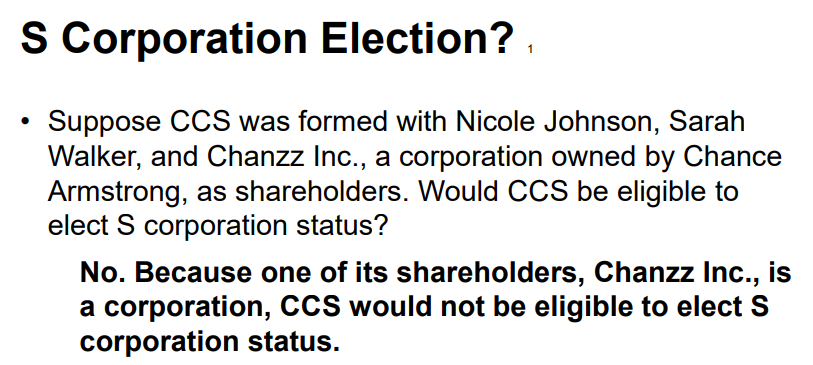
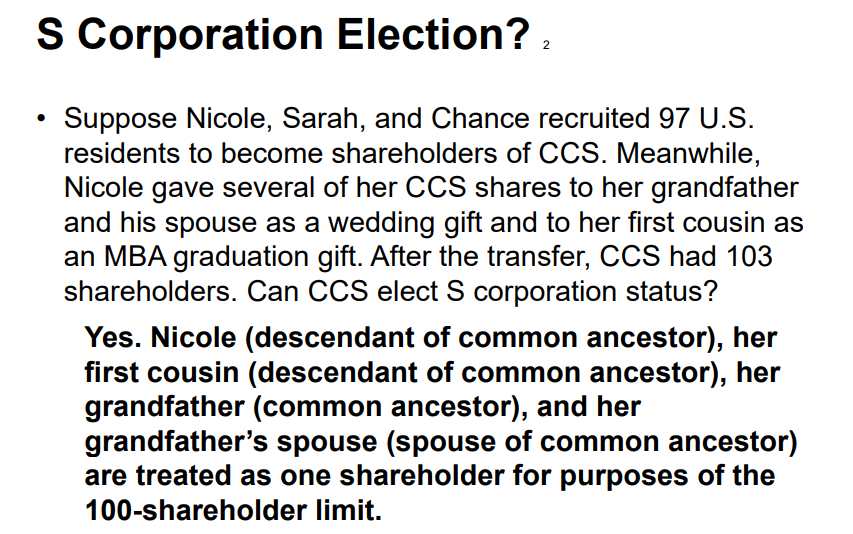
S Corporation Terminations
Once the S election becomes effective, the corporation remains an S corporation until the election is terminated
The termination may be voluntary or involuntary
Voluntary Terminations
Elected by shareholders with > 50% of stock (including nonvoting shares)
The corporation files a statement with IRS revoking the election under 1362(a) and stating effective date of revocation and shares outstanding
In general, voluntary revocations made on or before the 15th day of the third month of the year (March 15th) are effective as of the beginning of the year
A revocation after this period is effective the first day of the following tax year
Alternatively, an S corporation may specify the termination date as long as the date specified is on or after the date the revocation is made
Involuntary Terminations
Involuntary terminations can result from (1) failure to meet requirements (by far the most common reason) or (2) from an excess of passive investment income
(1) Failure to Meet Requirements
A corporation’s S election is automatically terminated if the corporation fails to meet the requirements
The termination is effective on the date it fails the S corporation requirements
If the IRS deems the termination inadvertent, it may allow the corporation to continue to be treated as an S corporation if, within a reasonable period after the inadvertent termination, the corporation takes the necessary steps to meet the S corporation requirements
(2) Excess of Passive Investment Income
Only applies to S Corporations which were previously C corporations and had C corporation E&P
If S corporation has E&P from a previous C corporation with passive investment income in excess of 25% of gross receipts for 3 consecutive years, election is terminated
Gross receipts = revenue received, capital gains, sales of stock, not reduced by deductions
Passive investment income = receipts from royalties, rents, dividends, interest and annuities
Net capital gain income is not passive investment income
Termination will be effective on the first day of the year following the third consecutive year with excess passive investment income
Short Tax Years
S corporation election terminations frequently create an S corporation short tax year (a reporting year less than 12 months) and a C corporation short tax year
The corporation must then allocate its income for the full year between the S and the C corporation years, using the number of days in each short year (the daily method)
Or it may use the corporation’s normal accounting rules to allocate income to the actual period in which it was earned (the specific identification method)
Both short tax year returns are due on the corporation’s customary tax return due date (with normal extensions available)
S Corporation Reelections
After terminating or voluntarily revoking S corporation status, the corporation may elect it again, but it generally must wait until the beginning of the 5th tax year after the tax year in which it terminated the election
The IRS may consent to an earlier election under a couple of conditions:
If the corporation is now > 50% owned by shareholders who were not owners at the time of termination, OR
If the termination was not reasonably within the control of the corporation or shareholders with a substantial interest in the corporation and was not part of a planned termination by the corporation or shareholders
Operating Issues: Accounting Methods and Periods
Like partnerships, elections to use accounting periods and methods are made at the entity level and elected with the filing of the tax return
S corporations are generally required to adopt a calendar tax year
May choose a non-calendar year-end if ≥ 25% of the gross receipts for the previous 3 years were recorded in the last 2 months of the year-end requested
S Corporations allocate profits and losses pro rata, based on number of outstanding shares owned by each shareholder on each day of tax year
S Corporations determine each shareholder’s share of ordinary business income (loss) and separately stated items
S corporations do not face restrictions for selecting cash method, unless selling inventory is a material income producing factor (must then use accrual for inventory)
Income and Loss Allocations
Allocate profit and loss pro rata, based on number of outstanding shares each shareholders own on each day of the tax year
An S corporation generally allocates income or loss items to shareholders on the last day of its tax year
If a shareholder sells their shares during the year, they will report their share of S corporation income and loss allocated to the days they owned the stock (including the day of sale) using a pro rata allocation
If all shareholders with changing ownership percentages during the year agree, the S corporation can instead use its normal accounting rules to allocate income and loss (and other separately stated items, discussed below) to the specific periods in which it realized income and losses

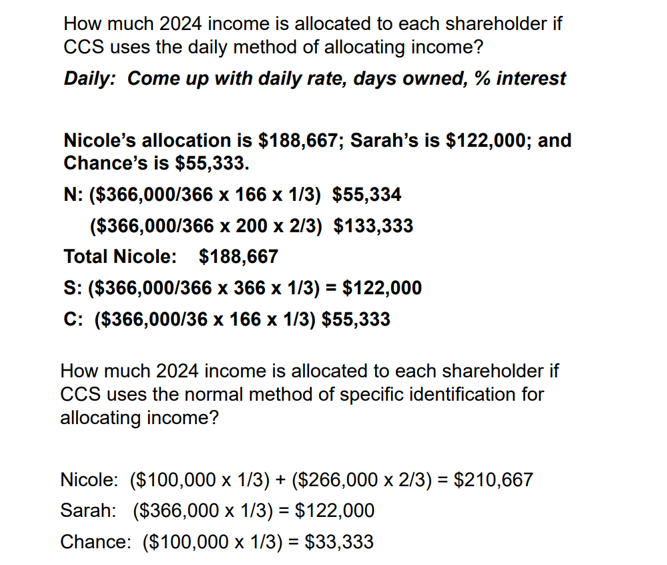
Separately Stated Items
S Corporations are required to file tax return 1120-S annual and Schedule K-1 to shareholders detailing amount and character of income and loss.
Shareholders must report their share of income and losses on their individual returns
Ordinary business income and separately stated items
S corporations do not report self-employment income and do not have guaranteed payments
S corporations may hold stock in C corporations, and any dividends S corporations receive will flow through to their shareholders
However, S corporations are not entitled to claim the DRD
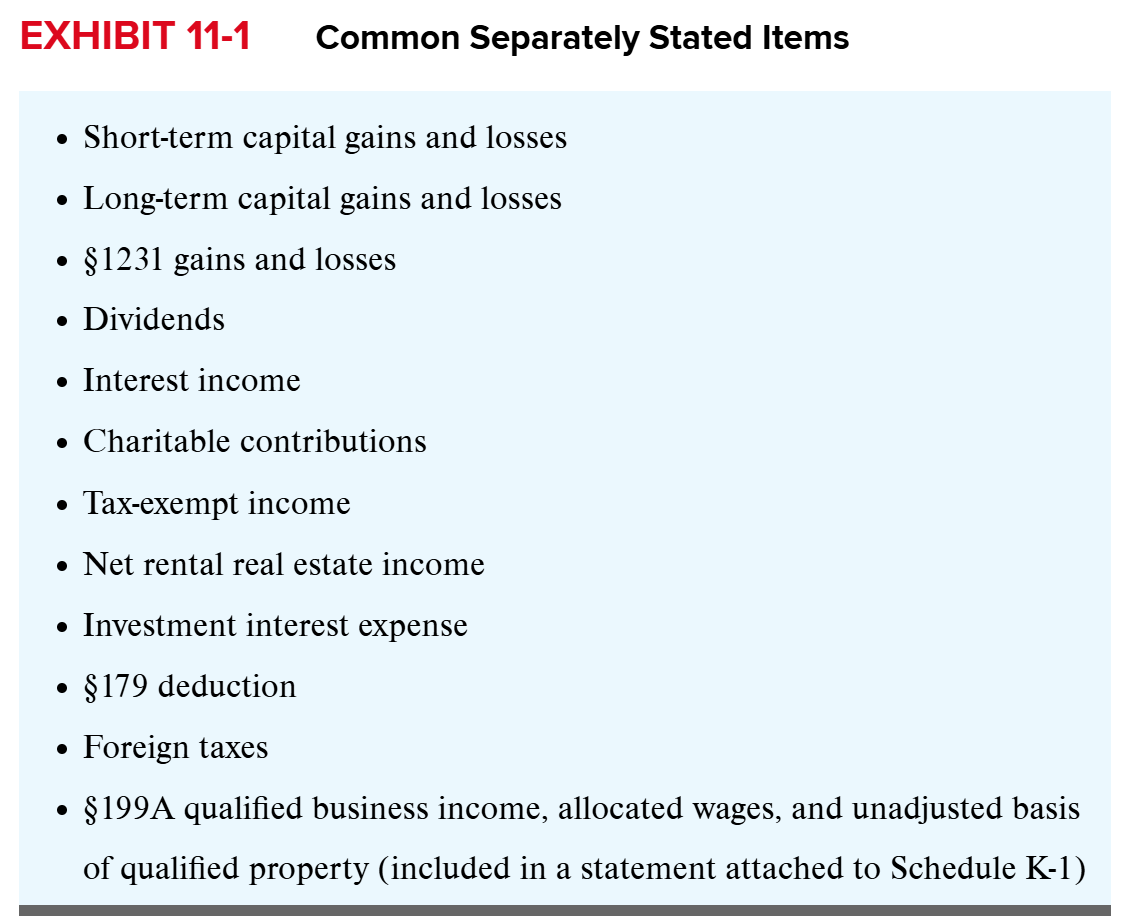
Shareholder’s Basis
Just as partners must determine their bases in their partnership interests, S corporation shareholders must determine their bases in S corporation stock to determine the gain or loss they recognize when they sell the stock, the taxability of distributions, and the deductibility of losses
C corporation rules govern the initial stock basis of S corporation shareholder, while subsequent calculations more closely resemble partnership rules

Initial Basis
Exchange of Stock
Shareholder’s basis in stock received = tax basis of property transferred, less any liabilities assumed by the corporation on the property contributed (substituted basis)
Increased by any gain recognized
Decreased by the FMV of any property received other than stock
Purchase of Stock
Shareholder’s basis in stock purchased = purchase price of the stock
Annual Basis Adjustments
A shareholder will increase the tax basis in their stock for
Capital contributions
Share of ordinary business income
Separately stated income/gain items
Tax-exempt income
A shareholder will decrease the tax basis in their stock for
Cash distributions
Share of nondeductible expenses (fines and penalties)
Share of ordinary business loss
Separately stated expense/loss items
A shareholder’s tax basis may not be < 0
S corporation shareholders are not allowed to include any S corporation debt in their stock basis
Loss Limitations
Loss limitation rules are similar to partnerships
For S corporation shareholder to deduct a loss, loss must clear (1) tax-basis, (2) at-risk and (3) passive activity hurdles; additionally, shareholder cannot deduct excess business losses
(1) Tax-Basis Limitation
S corporation shareholders cannot deduct losses in excess of stock basis
They cannot include debt in their basis
Losses exceeding basis are suspended until shareholder generates additional basis
A shareholder can mitigate disadvantage of not including S corporation debt in stock basis by loaning money to S corporation, creating debt basis (separate from stock basis)
Losses are first limited by stock basis and then to shareholder’s basis in any direct loans made to the S corporation
We first reduce (1) stock basis, then (2) debt basis
But, not < 0
In subsequent years, any increase in basis restores (2) debt basis first and then (1) stock basis
If S corporation repays debt owed to shareholder before debt basis is restored, a taxable gain is triggered
If the shareholder sells the stock before creating additional basis, the suspended loss disappears unused
(2) At-Risk Limitation
Shareholders may deduct S corporation losses only to the extent of their at-risk amount (§465)
S corporation shareholders are deemed at risk only for direct loans they make to S corporations
At-risk = sum of stock and debt basis
Losses limited under the at-risk rules are carried forward indefinitely until the shareholder generates additional at-risk amounts to utilize them or sells the S corporation stock
Post-Termination Transition Period (PTTP) Loss Limitation
Upon election termination, shareholder may create additional stock basis during post-termination transition period (PTTP) to utilize losses limited by basis or at-risk
PTTP begins on the day after the last day of the corporation’s last taxable year as an S corporation and ends on the later of:
1 year after the last S Corporation day, OR
The due date for filing the return for the last year as an S corporation (including extensions)
This rule allows shareholders to create stock basis (by capital contributions) during PTTP and to utilize suspended losses
Any losses not utilized at the end of the period are lost forever
Loss Limitations [Examples]
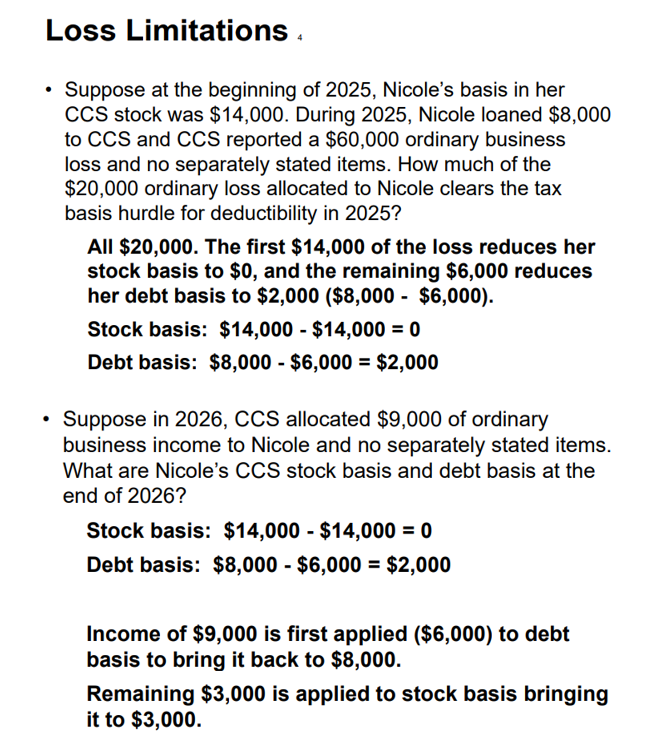
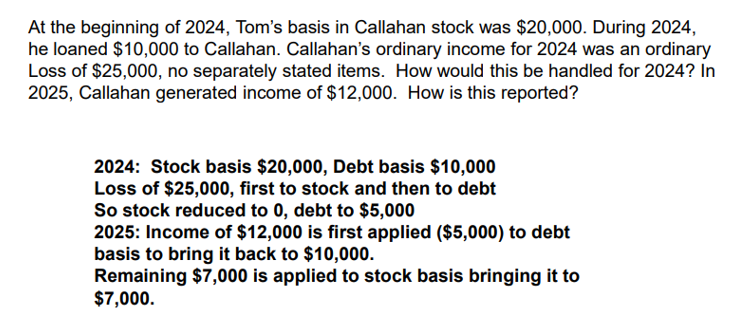
(3) Passive Activity Loss Limitation
As in partnerships, the passive activity loss rules limit the ability of S corporation shareholders to deduct losses unless they are involved in actively managing the business
No differences in the application of these rules for S corporations
Passive activity loss rules limit ability of S corporation shareholders to deduct losses of the S corporation unless the shareholders are actively managing the business
Excess Business Loss Limitation
Taxpayers are not allowed to deduct an “excess business loss” for the year
They are carried forward to subsequent years
This applies to losses that are otherwise deductible under tax-basis, at-risk and passive loss limitations
Threshold for 2024 is $610,000 MFJ and $305,000 for others
Self-Employment Income
S corporation shareholder’s allocable share of ordinary business income (loss) is not classified as self-employment income
Shareholder salary as employee is subject to Social Security taxes (SS and Medicare)
Tax-planning incentives
S corporation shareholders may desire to avoid payroll taxes by limiting or even eliminating their salary payments
However, if they work as employees, they are required to pay themselves a reasonable salary for the services they perform
If they pay themselves an unreasonably low salary, the IRS may attempt to reclassify some or all of the S corporation’s ordinary business income as shareholder salary
Net Investment Income Tax
S corporation shareholders are subject to the 3.8% net investment income tax on their share of an S corporation’s net investment income
Common types of investment income include interest, dividends, annuities, royalties, rents, passive income, and gains from disposing of property (other than property held in a trade or business)
Gains on sale of S Corp stock is subject to NIIT to extent it is allocable to assets that have generated a net gain if all S corporation assets were sold at FMV
Fringe Benefits
For shareholder-employees who own ≤ 2% of the S corporation, the S corporation gets a tax deduction AND the benefit is nontaxable to all employees
For shareholder-employees who own ≥ 2% of the S corporation, the S corporation still gets a tax deduction BUT many benefits are taxable to the shareholder-employees
Examples of benefits that are nontaxable to more-than-2-percent shareholder-employees (and partners in a partnership) include employee achievement awards (§74), qualified group legal services plans (§120), educational assistance programs (§127), dependent care assistance programs (§129), no-additional-cost services (§132), qualified employee discounts (§132), working-condition fringe benefits (§132), de minimis fringe benefits (§132), on-premises athletic facilities (§132), and medical savings accounts (§220)
Operating Distributions
The rules for determining the shareholder-level tax consequences of operating distributions depend on the S corporation’s history—specifically whether, at the time of the distribution, it has accumulated earnings and profits from a previous year as a C corporation
S Corporations Without E&P
Distributions are tax-free to the extent of shareholder’s basis
If distribution exceeds basis, capital gain treatment for the excess
S Corporations With E&P
Must determine accumulated adjustments account (AAA), an account that reflects the cumulative income or loss for the time the corporation has been an S corporation
AAA may have a negative balance but distributions may not cause the AAA to go negative or become more negative
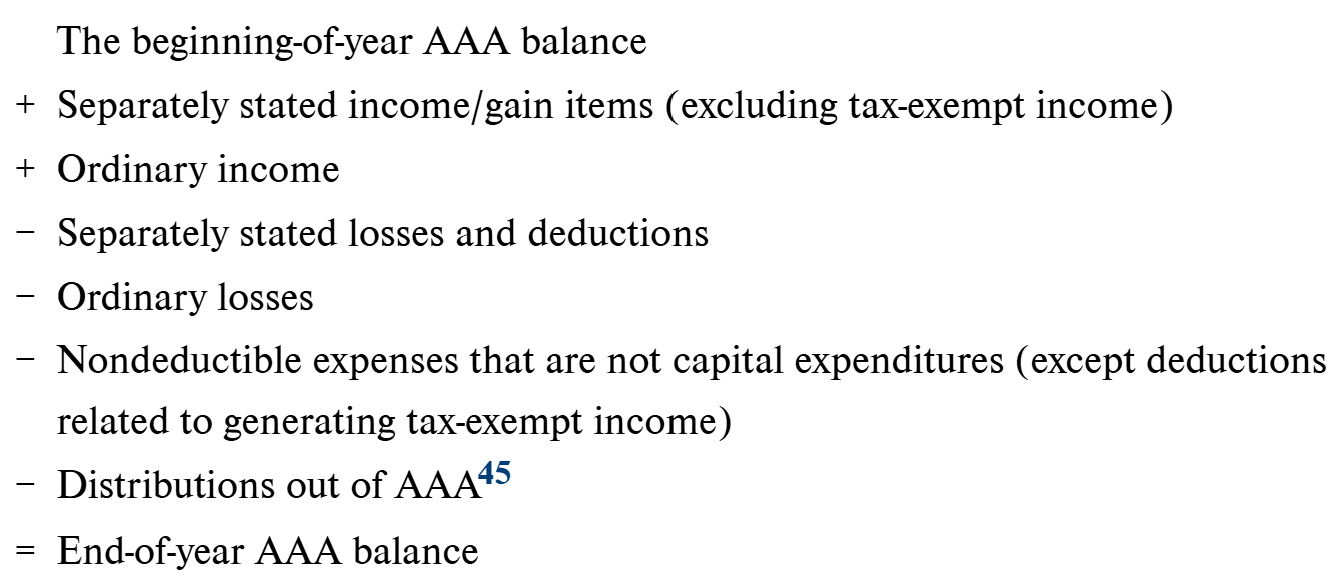
Distributions come from (in order)
AAA: nontaxable to extent of shareholder’s basis; any excess is capital gain
E&P: taxed as dividends
Any remaining shareholder stock basis: nontaxable to extent of shareholder’s basis; any excess is capital gain
Operating Distributions [Examples]


Property Distributions
S Corporation Consequences
Recognizes gain on distribution of appreciated property
Does not recognize loss on distribution of property whose value has declined (depreciated property)
Shareholder Consequences
Recognizes distributive share of the deemed gain and increase stock basis accordingly
The property distribution is the FMV of the property received (minus any liabilities the shareholder assumes on the distribution)
Taxability of distribution is determined based on distribution rules discussed previously (AAA and E&P rules)
Basis in property = FMV of property
Post-Termination Transition Period (PTTP) Distributions
Section 1371(e) provides special treatment of S corporation distribution in cash after S election termination and during post-termination transition
Cash distributions are nontaxable to extent they do not exceed AAA and shareholder basis in stock
The PTTP for post-termination distributions is generally the same as the PTTP for deducting suspended losses
Special rules apply for distributions after the PTTP for eligible terminated S corporations
Liquidating Distributions
S corporation rules follow C corporation tax rules
S corporations generally recognize gain or loss on each asset they distribute in liquidation
These gains and losses are allocated to the S corporation shareholders, increasing or decreasing their stock basis
In general, shareholders recognize gain on the distribution if the value of the property exceeds their stock basis; they recognize loss if their stock basis exceeds the value of the property
S Corporation Taxes and Filing Requirements
Although S corporations are flow-through entities generally not subject to tax, three potential taxes apply to S corporations that previously operated as C corporations: the built-in gains tax, excess net passive income tax, and LIFO recapture tax
Built-in Gains Tax
Congress enacted the built-in gains tax to prevent C corporations from avoiding corporate taxes on sales of appreciated property by electing S corporation status
The built-in gains tax applies only to an S corporation that has a net unrealized built-in gain at the time it converts from a C corporation to the extent the gains are recognized during the built-in gains tax recognition period
The built-in gains tax recognition period is the 5 year period beginning with the first day of the first taxable year the corporation operates as an S corporation after converting from a C corporation
Net unrealized built-in gain is the net gain (if any) an S corporation that was formerly a C corporation would recognize if it sold each asset at its FMV
The corporation’s accounts receivable and accounts payable are also part of the computation: Under the cash method, accounts receivable are gain items and accounts payable are loss items
If the S corporation has a net unrealized gain at conversion, it must compute its net recognized built-in gains for each tax year during the applicable built-in gain recognition period to determine whether it is liable for the built-in gains tax
Recognized built-in gains and losses include gains and losses for any asset sold during the year (limited to unrealized gain/loss for the specific asset at the S conversion date)
Net recognized built-in gain is limited to the least of
Net recognized built in gain less any NOL and net capital loss carryover
Net unrealized build-in gains not yet recognized
Corporation’s taxable income for the year using C corporation tax rule
Excess Net Passive Income Tax
Excess net passive income tax is a tax levied on an S corporation that has accumulated earnings and profits from years in which it operated as a C corporation if the corporation reports excess net passive income
Congress created this tax to encourage S corporations to distribute their accumulated earnings and profits from prior C corporation years
It does not apply to S corporations that never operated as a C corporation, or to S corporations without earnings and profits from prior C corporation years
Levied on excess net passive income

Applies when passive investment income exceeds 25% of gross receipts
Passive investment income includes royalties, rents, dividends, interest, annuities
Net passive investment income is passive investment income reduced by expenses connected with producing that income

LIFO Recapture Tax
C corporation must include the LIFO recapture amount (FIFO basis − LIFO basis) in gross income in the last year it operates as a C corporation
Tax paid in four annual installments
The LIFO recapture amount increases the corporation’s adjusted basis in its inventory at the time it converts to an S corporation
Estimated Taxes
Generally follow C corporation rules: S corporations with a federal income tax liability of ≥ $500 due must make quarterly estimated tax payments
Not required to make estimated tax payments for the LIFO recapture tax
Filing Requirements
Form 1120-S due by the 15th day of the third month after the S corporation’s year-end (March 15th)
Automatic 6 month extension by filing Form 7004 (September 15th)
Note the K-1 of the 1120-S is different from the K-1 of the partnership Form 1065
In contrast to the 1065 Schedule K-1, the 1120-S Schedule K-1 does not report self-employment income, does not allocate entity-level debt to shareholders, and does not allow for shareholders to have profit-and-loss-sharing ratios that are different from shareholders’ percentage of stock ownership
Comparing Tax Consequences


